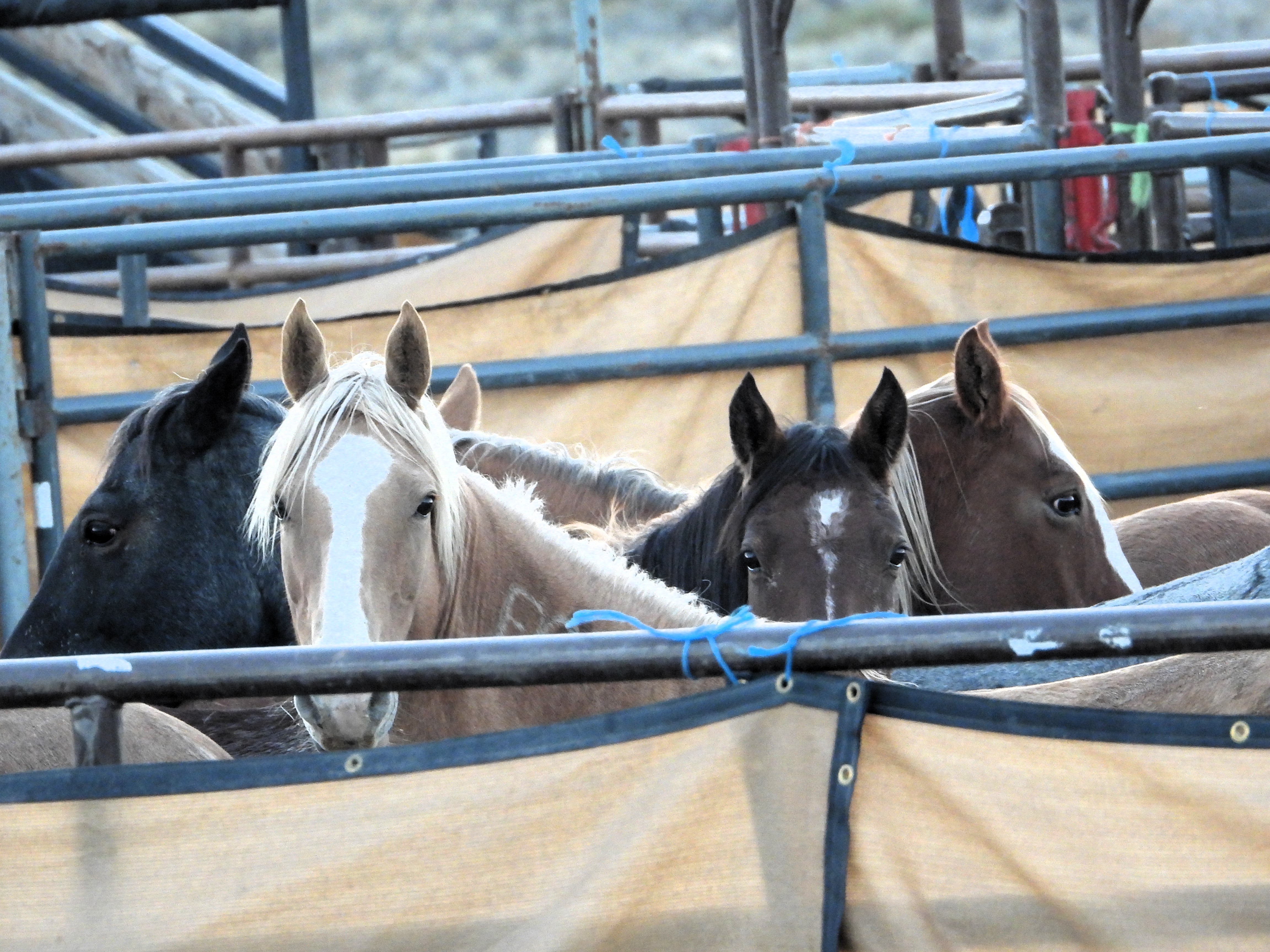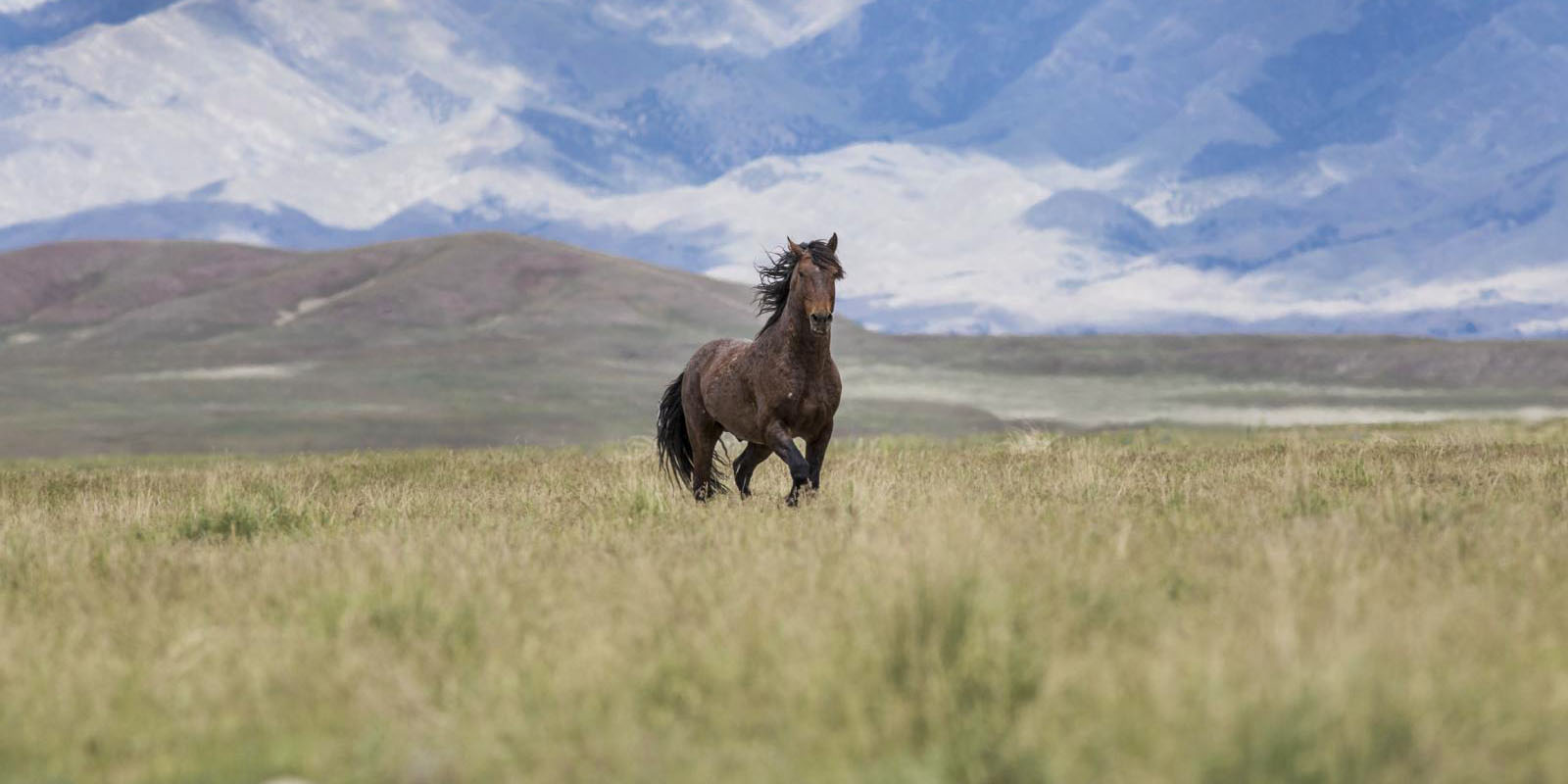BACKGROUND
On or about October 1, 2023, the BLM plans to round up 569 wild horses from the 584,000-acre Calico Complex in Nevada. The BLM sets an Appropriate Management Level (AML) of 467 - 777 wild horses. Approximately 151 mares are to be treated with the controversial fertility control vaccine, Gona Con, and then be released with approximately 171 stallions.
Roundup: Calico Complex Mare Release
Date: December 4, 2023
Location: Granite HMA
Weather Conditions:
- 59° F
Summary:
Today, 90 treated mares were released back to the Calico Complex (with 145 stallions previously released, this puts the ratio of released mares to stallions at 2:3). The change from the originally estimated number of mares to be released, according to Wild Horse and Burro Specialist Garrett Swisher, was based on population counts obtained in a helicopter flyover last week. The Bureau of Land Management made the decision to keep the population in the complexes at low AML. Released mares have an FC brand on the neck. 10 mares were also outfitted with collars and will be monitored by the USGS.
Observations and Events:
- 3 members of the public were present, including AWHC
- 10:30 AM: Met in front of Bruno’s Country Club
- 12:42 PM: Trailers carrying the mares arrive
- We follow two of the trailers to the first release location
- 17 mares were released
- Mares were already being released at the second location by the time AWHC arrived
- 73 mares were released at the second location
- All mares had an FC brand on the neck
- Some mares had a BLM freeze brand on the neck in addition to the FC
- 10 mares had collars for monitoring by the USGS
- The collars are designed to fall off
o If they do not, the BLM indicated that a second roundup will be required to remove the collars from these mares
Video of the released mares, including one of the mares outfitted with a collar.
An example of the BLM freeze brand and the letters “F”and “C” branded onto released mares.
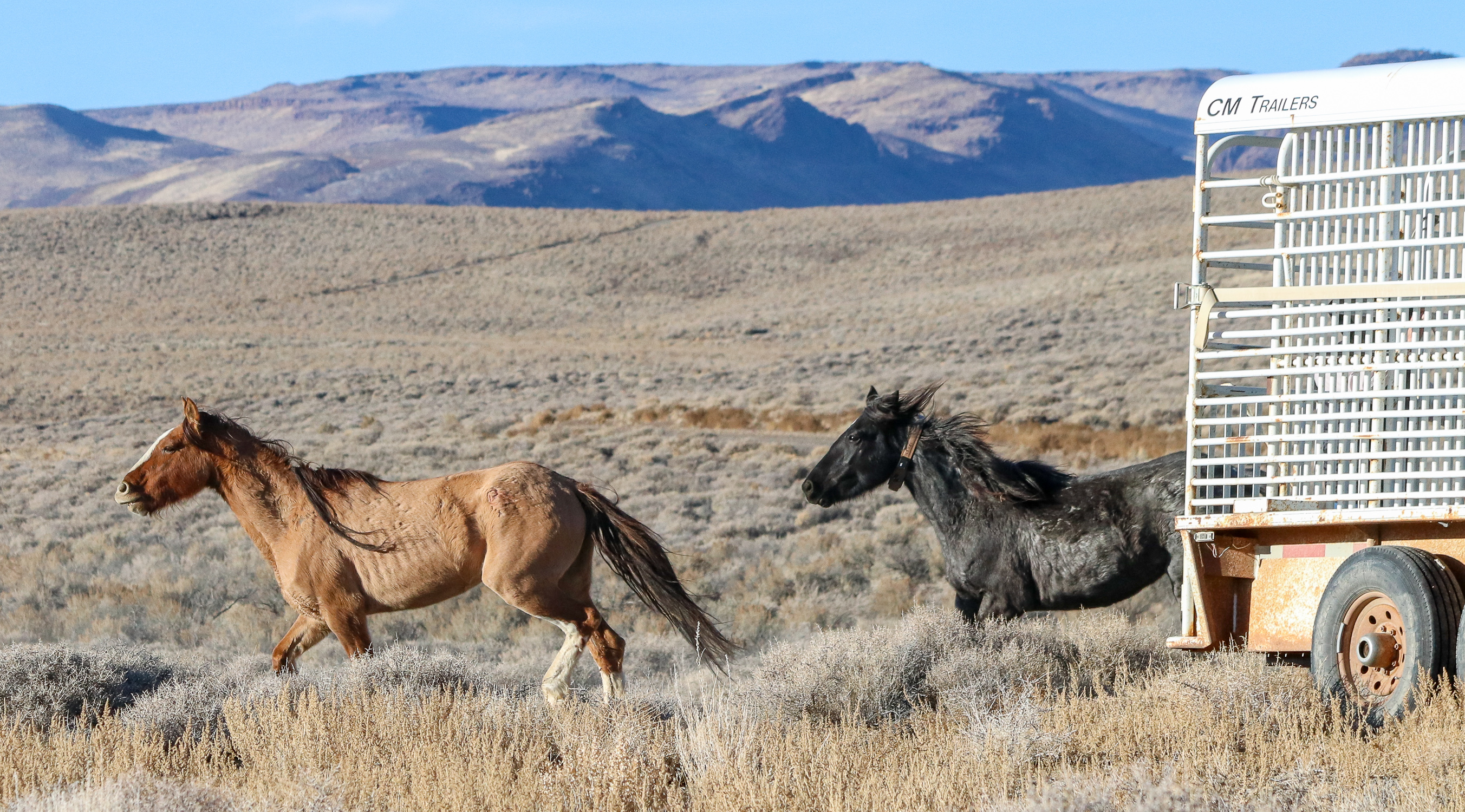
Two released mares leaving a livestock trailer. One is wearing a radio collar which will be monitored by the USGS.
ROUNDUP REPORT
The roundup concluded with 489 wild horses captured, and 15 deaths.
October 16, 2023: 41 wild horses were captured today.
41 horses were captured in the Leonard Creek Rd area. AWHC was the only organization present for public observation. Our observer had a clear view of the trap, loading and wings. The Judas horses were used to lead the other horses into the trap, which was set up with wings at a right angle. It's worth noting that the temporary holding was on private property and not open to the public. Additionally, no overhead padding was seen at the trap site.
October 15, 2023: No wild horses were rounded up today.
We met with BLM at 7:30 am and followed them along with three trailers via the playa to Soldier Meadows Rd. At Soldier Meadows reservoir, they lined up the trailers and released 35 stallions. As the stallions came off the trailer, they shook the dust off from the ride over the playa. After the release, we drove up to the area where they ran, but we only found three of them. Interestingly, two of the stallions had spray paint on them – one with a blue line from his mane down to his tail and the other with pink/red sprayed on his mane. We're not sure what the significance of the markings is at this time.
October 14, 2023: No wild horses were rounded up, but one 25+ year-old mare was euthanized due to a poor body score condition and a loss of teeth. The BLM released 35 stallions back to the HMA.
AWHC’s observers met the BLM at 7:30 a.m. to drive to the observation meeting point. We followed BLM and 3 trailers via the Playa to Soldier Meadows Rd. At the Soldier Meadows reservoir, they pulled the trailers into a row and released 35 stallions. As the stallions came off the trailer they were shaking the dust off them due to the ride over the Playa. After the release, we drove up towards the area that they ran after the release but were only able to find 3 of the stallions. Two of them had spray paint on them, One Blue that line that went from his mane and one down his back to the tail, and the other one had pink/red sprayed on his mane. We are unsure of the significance of these markings.
October 13, 2023: 28 wild horses were rounded up and one 20+ year old bay stallion was euthanized due to a "chronic pre-existing condition"
We met BLM personnel at 5:30 a.m. The temperature was 29°F. We followed them out via the playa until we got back onto Soldier Meadows Road and proceeded toward observation. We were at the same location and trap as yesterday. We arrived at approximately 7:45 a.m. and then hiked up to the observation site. At 9:10 am the pilot came in to refuel. then at 10:06, he brought in 6 horses. The next run was at 10:35 and 11 horses were captured. At 11:35, 4 horses came in. Then the final run happened at 12:00 with 3 to 4 horses caught. The BLM called it a day at 1:30 pm.
October 12, 2023: 43 wild horses were captured
We met the BLM at the turnoff on 530 Soldier Meadows Rd and traveled through the Playa to reach Soldier Meadows Rd. We arrived at 8:00 a.m. and the temperature was 38°F.
We hiked approximately ⅛ of a mile to the observation area. The trap is located to the right of me, about ¼ of a mile away. I can see the alley of the trap, but not the wing entrance due to a tarp obstructing my view on the catch pen rails. I have a partial view of the loading area and can see trailers departing to temporary holding.
As the sun came out, it warmed up and there wasn't much wind. The sky is clear today. At 9:30, the pilot came in to refuel and took off at 9:35, heading in a different direction than before.
At 9:44, I could still hear the pilot in the far distance southeast of the observation area, bringing in horses. It has been two and a half hours since I've been sitting at the observation area. The pilot has been out-moving horses and refueled once.
At 11:36, 9 horses came in. The pilot refueled again at 2:30 and we were instructed to pack up and move quickly because the pilot was bringing in horses to where we were sitting. We moved down into the ravine and waited.
The pilot brought in about 15-19 wild horses at 3:00 and 3 more at 3:10. At 3:46, he brought in 5 more and called it a day.
October 11, 2023: 40 wild horses captured today.
We met BLM personnel at 5:30 am at the Soldier Meadows turn-off. We then proceeded to drive up Soldier Meadows Rd and turned onto a round behind Soldier Meadows Ranch. By approximately 8 am, we reached the observation point after hiking for about 1/8 of a mile.
From our vantage point, we could see a trap situated about 1/4th of a mile below us. The weather on that day was chilly, with overcast skies and a noticeable wind. The first run occurred around 8:30 am, with two horses being brought into the trap. The second run took place at 10:00 am, during which the pilot attempted to bring six horses into the wings of the trap. However, the horses managed to evade the trap and instead ran up the hill. Two of them even split off and went in a different direction. The pilot made efforts to pursue them and get them turned around, but unfortunately, his attempts were unsuccessful. As they ran up the hill, the cold air caused their breath to be visible.
The next attempt, again with six horses, also failed to bring them into the trap. The pilot continued to pursue them behind the hill for approximately 20 minutes before deciding to back off and refuel. At 10:45 am, two more horses, including a foal, came into the trap. The pilot refueled at 11:00 am. Due to rain starting around 2:00 pm, the observation vehicle had to leave. However, the pilot managed to make two more runs before calling it a day at 4:30 pm, bringing in approximately 30 horses.
During the day's operations, it seemed that the pilot frequently pursued the horses behind a restricted view of the mountain for an extended period. Since I was unable to see that area, it is uncertain if he had more horses there that he decided to bring in. The sound of the helicopter indicated that he continued to pursue one band of horses after they evaded the trap.
Although I did not have a tour of the trap, it appeared to be set up correctly. However, without seeing the opening of the wing, it is difficult to determine why the pilot encountered difficulties getting the horses to enter the wing area. Instead, they would run past it and up the hill.
Unfortunately, due to the presence of a tarp at temporary holding, I was still unable to assess the condition of the horses. Nonetheless, I managed to capture a few photos from a nearby hill, although I did not have the opportunity for a closer look.
October 10, 2023: No wild horses were rounded up today, but there was one death after the BLM euthanized an 11-year-old blue roan mare for a preexisting condition.
October 9, 2023: 31 wild horses were captured and three were killed after the BLM euthanized:
- A 6 year old sorrel stallion for being blind
- A 25-year old stallion who had a fracture of the right front knee and was blind in his left eye
- A 25-year old mare who was missing a right eye.
I met the Bureau of Land Management (BLM) at Soldier Meadows turnoff. The weather was overcast with scattered rain, and the temperature ranged between 50 and 63. We traveled up Highway 34 and turned onto High Rock Canyon Road, covering a distance of 33 miles. We arrived at the observation point at approximately 7:10 a.m., which is located about half a mile from the trap.
From this vantage point, I was able to observe the alleyway leading to the catch pen and loading area. The first run of horses came in at 11:00 a.m., bringing in a total of 9 horses. The second run followed at 11:30 a.m. and brought in 7 horses. Despite the windy and colder weather compared to the previous day, the horses in both runs appeared to be healthy. Notably, a younger cremello horse was among the horses in the second run.
At 11:54 a.m., the first trailer passed by to go to temporary holding. The pilot refueled at 2:10 p.m., and at 2:30 p.m., 5 more horses were brought in, including a beautiful pinto paint yearling. All the runs so far proceeded without any incidents. Unfortunately, there is still no padding on the bars at the trap, and the weather remains windy with strong gusts and rain.
At 2:50 p.m., I could still hear the pilot flying nearby. At 2:56 p.m., he emerged from behind the knoll, bringing in 4 more horses and loading them onto the trailer. At 3:17 p.m., another trailer arrived to transport horses to temporary holding. During this time, one of the horses, the cremello, lost footing and hit its head on the trailer.
At approximately 4:00 p.m., around 7 more horses were brought in, and at 4:30 p.m., the day's operations were concluded. We waited for the trailer to be loaded and then headed towards temporary holding.
October 8, 2023: 18 wild horses were captured and there was 1 death after the BLM euthanized a 20+ year old stallion for a pre-existing snake bite.
We met the BLM at the turnoff to Soldier Meadows and followed them over the playa and up Soldier Meadows Road to the turn leading to Sheldon Wildlife Refuge. We reached the designated parking area at approximately 10:00 am.
At this location, we noticed that the observation/trap area remained the same as in the past three days. Unfortunately, there was no clear view of the horses entering or leaving the wing or the alley. Due to a tarp and trucks blocking the view, we only caught a few seconds of the horses passing by as they entered the catchpen and trap. The loading process was also obstructed from our vantage point. Only two runs occurred today.
The helicopter was fueled and airborne by 10:05 am. The first run, consisting of five horses, took place at 10:45 am, followed by the next run at 11:30 am, which involved seven horses. From my position, it was difficult to assess the horses' condition accurately, but their backs appeared wet, possibly due to sweat, reflecting the sunlight.
At 12:25 pm, a truck transported the captured horses to the holding area, and at 12:36 pm, the helicopter refueled and went back out, but no additional horses were brought in. By 3:30 pm, operations for the day were concluded. We arrived at the temporary holding area at approximately 5:30 pm, where I managed to take a few pictures, although I was not permitted to walk around.
According to the BLM, the body scores of the horses observed were approximately 4 to 5. The trap was located approximately 1/8 of a mile away, but our positioning prevented us from seeing the horses entering the wings or the alley. Despite requesting a different observation location, our request was denied.
The weather conditions during the observation period were relatively mild, with temperatures ranging between 59° and 69° Fahrenheit. The sky was clear, with wind gusts reaching up to 4 mph.
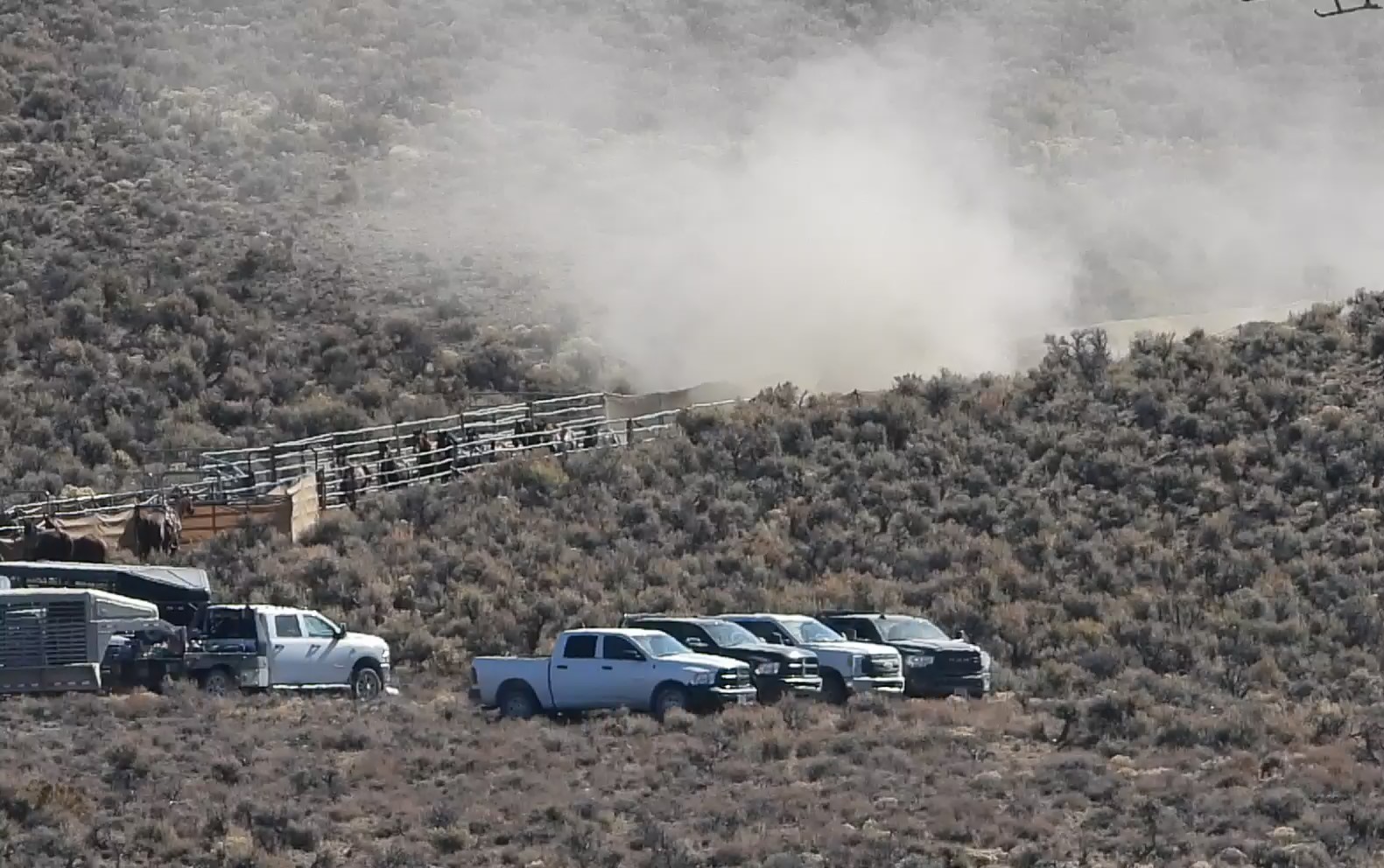
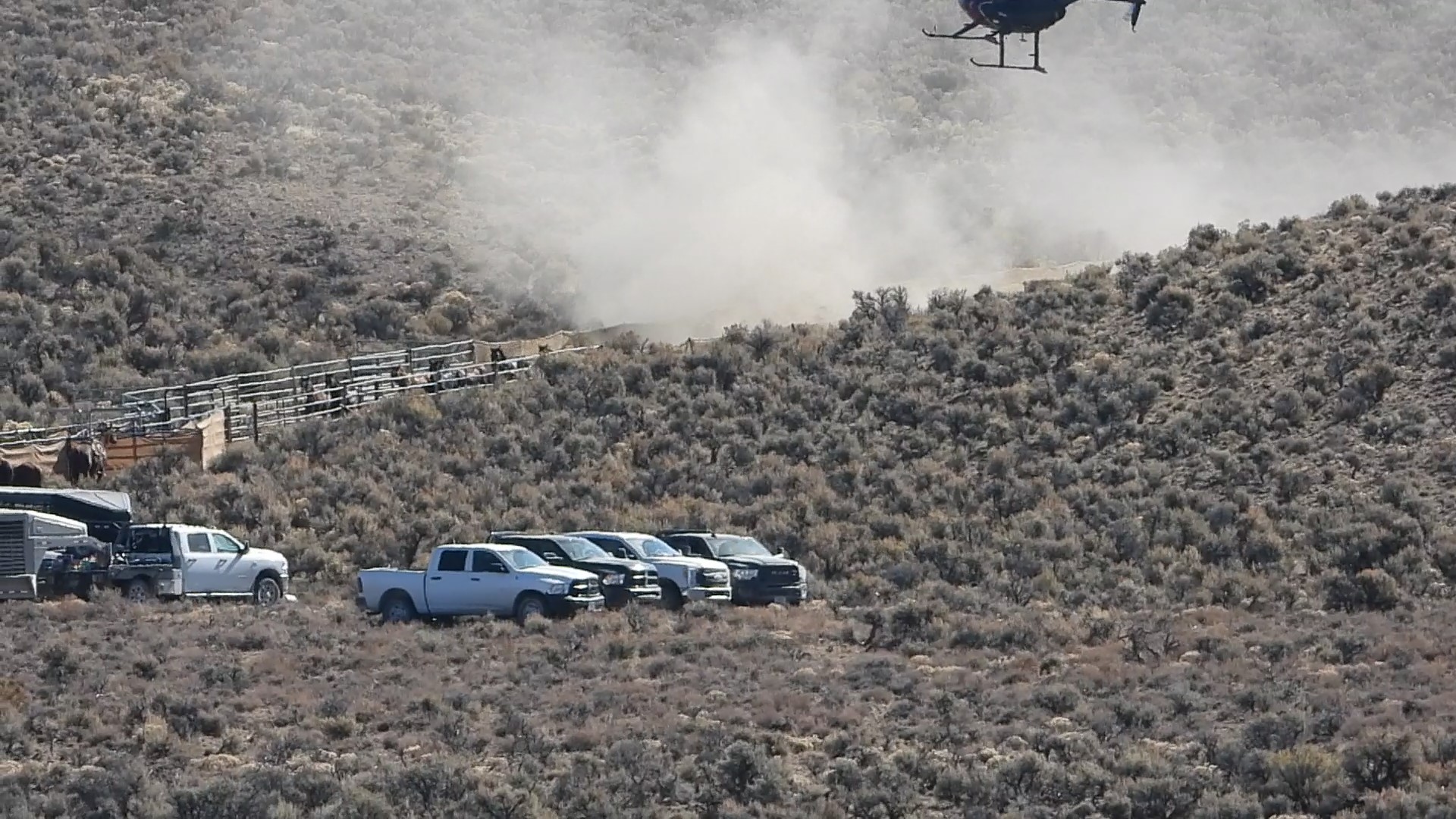
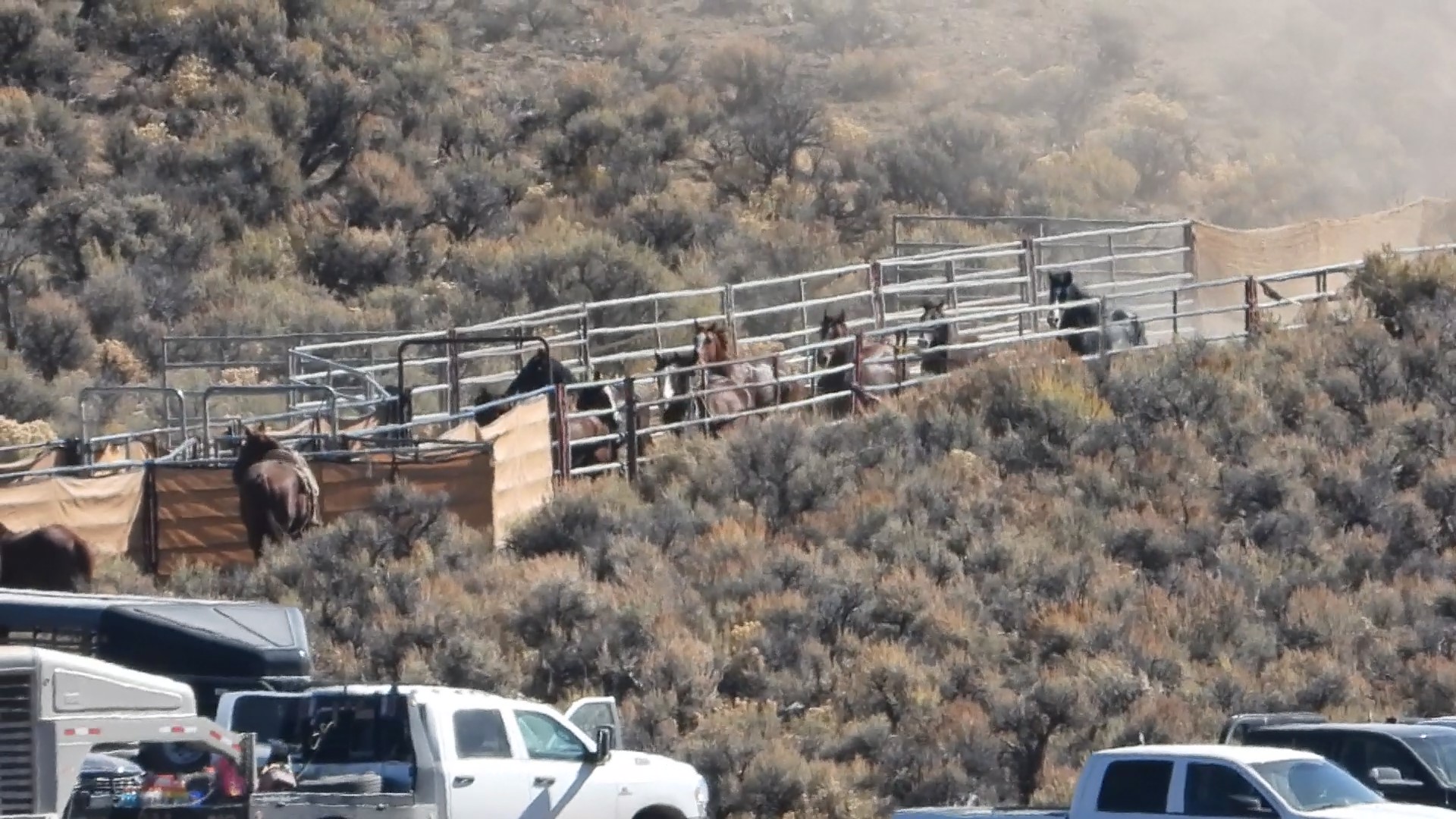
October 7, 2023: The BLM rounded up 70 wild horses today. The BLM euthanized a 25+ year old stallion due to a "previous fracture right rear leg."
October 6, 2023: The BLM captured 36 wild horses and one 25+ year old mare was euthanized due to "ulcerated cancer of the withers." We met at the observation point at 5:00 a.m. and drove to the same location as yesterday.
We arrived at the observation point at 7:00 a.m. Due to the condition of the roads, it takes two hours for us to get to the observation place. When the horses are trailer to temporary holding, they are trailered on the same road and they crossing the very dusty playa, raising concerns about the potential impacts of this on them.
When we arrived the helicopter was already in the air. We hiked up the hill to the observation point and we were told we had to sit in the same location, which has no view of any of the operations except a minute of the horses passing into the blocked view catch pen.
The trap is only approximately 1/4 mile away from where we are placed, however, we are up on a hill that allows you only to see the portion of the trap that is covered with snow fencing. We are unable to see the horses coming up into the wing or alley of the trap or coming in off the range. We can not view loading due to the trucks parked in the way,
At 9:00 a.m. pilot came in and refueled.
The Runs:
- The first run was visible at 11:55 there were 7 to 8 horses captured.
- The second occurred at 12:44 with 6 horses
- The third run was at 1:48 third run had 6 horses.
- The pilot then refueled and went back out by 2:15. At this time, no other horses had come in, so we made our way back down to the vehicles.
- Around 3:15 the helicopter brought in one more group of horses and then at 4:00 pm we were told we would be heading back
About halfway back, we had to stop and wait for a trailer to have a tire changed. At this time, we were told we would not be able to go to holding (AGAIN) due to how late we would be getting back in. I asked about the trap location and viewing for tomorrow when I RSVP'd and requested that the observation be relocated to a different area but was told that there would be no change and that observation would be at the same location.
October 5, 2023: 32 wild horses were captured and there were two deaths after the BLM euthanized a 25+-year-old stallion who was blind in one eye and missing upper teeth and an 11+-year-old sorrel mare who was euthanized for blindness.
At 8:00 am, we arrived at Warm Springs HA, after driving 70 miles to the trap area. The contractors were waiting for the Bureau of Land Management (BLM) IC (Incident Commander) to give the go-ahead to proceed to the new trap area.
By 10:30 am, the team reached the trap area and waited while the jute was hung and the trap was set up. Since there was no existing fence to hang the jute, all the posts had to be placed in the ground, which took some time.
At 11:30 am, the observer hiked up to a spot approximately ⅛ of a mile from the vehicles. From there, they could see the trap located about ¼ of a mile below them. However, the view of the opening of the wings or the alley was limited due to blocked visibility caused by trucks.
By 12:35 pm, the observer could hear the helicopter down in the knoll for the last 20 minutes. Based on the sounds, it seemed that the horses might have turned or there were issues pushing them into the wing.
At 1:15 pm, the first run occurred, but the observer couldn't see much. Approximately 4 or 5 horses were involved in that run. The helicopter refueled and went back out.
By 2:51 pm, 7 horses came in, and the wranglers went out on horseback. One horse came back, but it was difficult to see clearly.
Around 3:15 pm, approximately 5 more horses came in.
At 4:00 pm, 6 to 8 horses were involved in the run.
Finally, at 4:10 pm, the team called it a day.
October 4, 2023: 36 wild horses were captured and there were 3 deaths after the BLM euthanized an 11+-year-old roan mare for having a prolapsed uterus, a 20+-year-old grey stallion due to a fracture of the right hind leg at the knee, and a 20+-year-old black stallion for having a fracture of the right front leg.
The weather conditions started cold but warmed throughout the day, with temperatures ranging from 30° to 69° F. There were sunny skies with winds between 10-5 MPH. The day began at 6:15 am with a temperature of 30° when meeting BLM at the Soldier Meadows Road turnoff. The observation site was reached at around 7:00 am after hiking up a hill. At 9:00 am, the helicopter came in to refuel.
The first run brought in 11 horses at approximately 11:45 am. The second run occurred at 2:30 pm and brought in 9 horses. At 2:40 pm, the pilot refueled and went back out. Around 3:30 pm, 7 more horses came in, and one yearling veered off from the group. Four wranglers went out, roped the yearling, and brought it in without incident.
At 3:48 pm, the pilot brought in 4 more horses. At 5:03 pm, they were waiting for the contractors to tear down the trap, and it was mentioned that they would be at a new trap location the following day. At 6:24 pm, we traveled to temp holding.
Due to the snow fencing/tarp material being used, it was not possible to physically see the condition of the horses, including their hooves, legs, or any body injuries. However, hay and water were observed on the outside of the pens. A few mares with the FC brand on their neck were seen, and it was assumed that they would be treated again and released. There was also a vet on site. Body scores, as observed from the camera view, appeared to be around a 5.
Please note that without being able to view inside the pen area, it was not possible to provide a detailed assessment of the horses' condition.
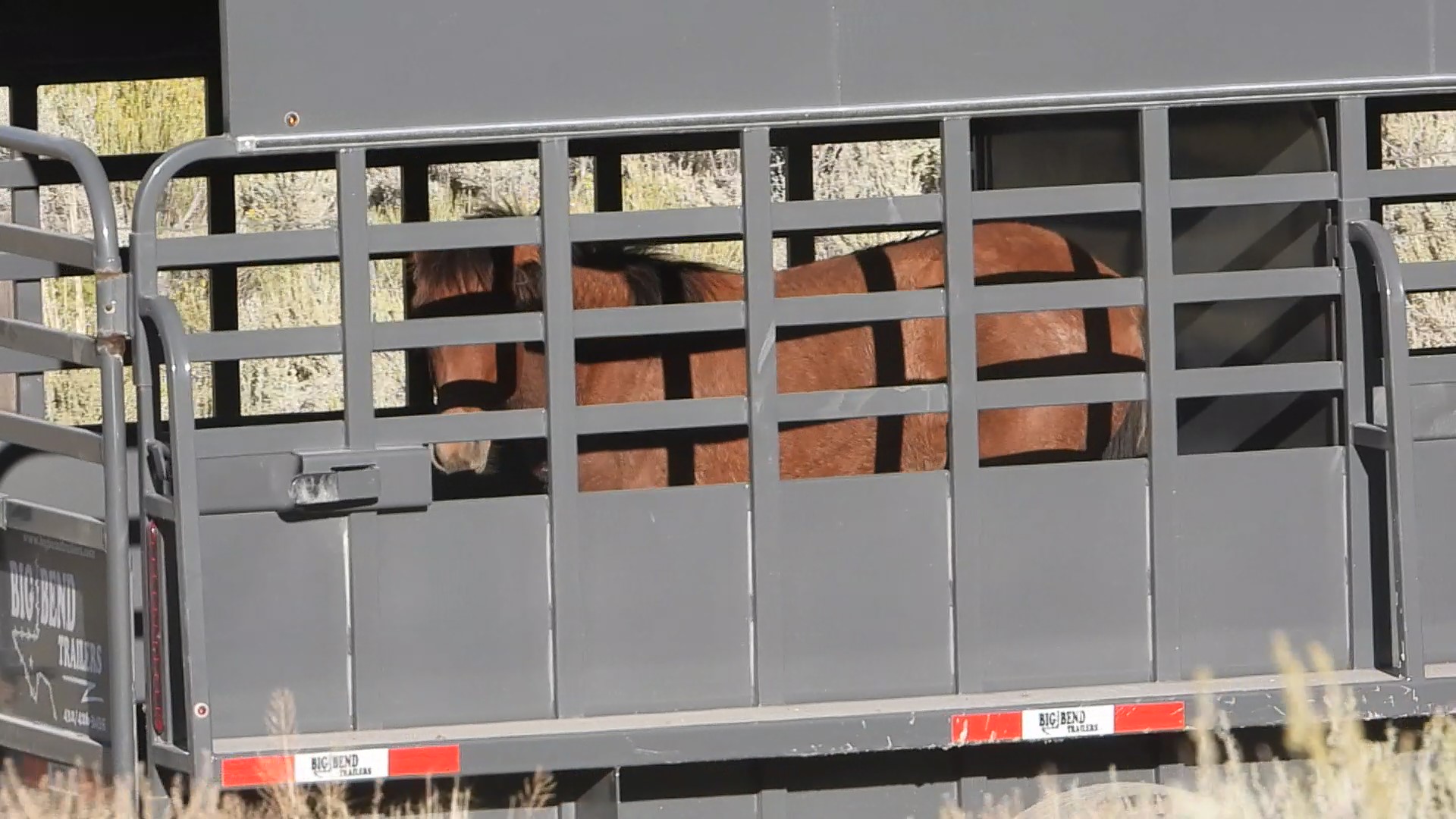
October 3, 2023: 50 wild horses were captured and there was 1 death after the BLM euthanized a 20+-year-old buckskin mare due to a "pre-existing" fracture of the front right shoulder.
On the day of the observation, the temperature ranged between 50° and 59° with scattered rain throughout the day. The meeting with BLM took place at 9:00 am at the Soldier Meadows Road turnoff just outside Gerlach, NV. It was noted that 21 stallions were released back into the Granite Range by BLM, but no public observation was offered for the release.
The observation team then drove to the observation area and new trap site located approximately 10 miles up High Rock Canyon Rd (Calico Mnt HMA). A short hike was required to reach the observation area. The trap and wings were visible, with only a portion of the alleyway being hidden. It was easy to view the trap area. Four runs were observed, and it appeared that the horses were not spooked as they entered the trap area.
The day concluded around 4:00 pm at the trap, after which the team drove to the temporary holding area, which is about 2 miles from the Soldier Meadows turnoff going back towards Gerlach. The option for a walk around was offered, but the observer requested to have a spot to view the corral area instead. The observer expressed concern about the stress caused to the horses by the solid snow fencing, as they were unable to see the observer but could hear them.
October 2, 2023: 68 wild horses were captured.
October 1, 2023: Approximately 25 wild horses were captured
I met with BLM personnel at 7:30 am at the Soldier Meadows turn off on Hwy 34. We then drove approximately 11-13 miles to the observation site. However, our operations were put on hold due to rain, and we were instructed to go to town and wait for a phone call.
Around 11:00 am, we received a text message asking us to meet back at the original location. Once again, we followed the personnel to the observation area. Initially, we were told it would be a half-mile hike up the hill, followed by a flat terrain. However, the exact location was uncertain, and we ended up hiking further than anticipated before eventually turning back.
The weather remained overcast, cold, and windy throughout the day. The first run of horses came in at 2:30 pm, with approximately 17 horses. They were brought down the notch into the valley, but they were quite far from our position closer to the trap. I had an okay view of the alleyway of the trap from where I was positioned, so I tried to concentrate on that view. Loading the horses into the trap seemed a bit chaotic, but it was hard to see clearly.
I noticed a truck and trailer coming down towards us, but it veered off onto a road that was blocked from our view. The second run occurred around 3:30 pm, and it involved four horses who appeared to be tired. Once again, they came from the same area, making it difficult to view them properly.
In between these runs, the wranglers went out and shooed the cattle away from the trap area. After the second run, they called it a day. The temporarily holding area for the horses is in the same location as last year, at the county lot off Hwy 94. The snow fencing was solid, making it impossible to see the horses. I decided not to walk around as it seems to agitate the horses when they can hear us but not see us.

